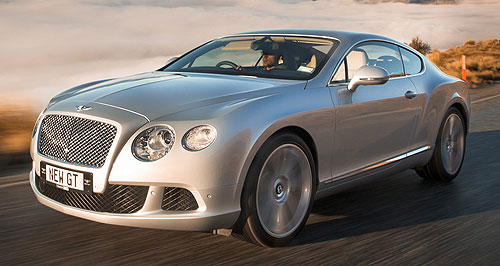Make / Model Search
New models - Bentley - Continental - GTFirst drive: Bentley spices up Conti GTHigh T: Bentley’s Gen II Conti GT is brimming with techno treats and a sportier demeanour. More power, sharper dynamics and tech treats headline Bentley’s new Continental GT13 May 2011 By JACQUI MADELIN in NEW ZEALAND BENTLEY has launched its second-generation Continental GT luxury four-seater coupe, which has undergone a host of engineering and design improvements including a reworked chassis, hi-tech cabin features and higher outputs from its twin-turbocharged W12 engine. The Volkswagen-owned British prestige brand sold 23,000 versions of the outgoing GT worldwide from its 2003 launch to the present day – more than the 16,000 cars the Bentley marque had managed in the 80 years preceding its arrival. At the redesigned model’s launch in New Zealand this week, Bentley Motors Limited’s regional manager for South East Asia and Australasia, Ed Striebig, told GoAuto that around 250 Gen I Conti GTs had been sold in Australia, primarily in Sydney but closely followed by Melbourne and Brisbane, and that he expected 80 to 90 registrations this year –up 50 per cent on 2010 – with continued growth as market conditions improve. Priced from $405,714 (plus on-road costs) and selling initially in a single specification, the all-new GT closely resembles the current model but has emerged as a more driver-focused vehicle. At its core is the more powerful 6.0-litre twin-turbo W12 engine, up 11kW to 423kW at 6000rpm with torque boosted by 50Nm to 700Nm – and available from just 1700rpm.  Drive continues to all four wheels via an uprated six-speed ZF ‘Quickshift’ automatic transmission and a new Torsen centre differential which now splits torque 40:60 front/rear – as seen on the current high-performance Supersports model. Drive continues to all four wheels via an uprated six-speed ZF ‘Quickshift’ automatic transmission and a new Torsen centre differential which now splits torque 40:60 front/rear – as seen on the current high-performance Supersports model.Transmission shift times are said to have halved to just 200 milliseconds, while the revised gearbox also now has the ability to deliver double downshifts, such as fourth to second. With a 65kg weight reduction (to 2320kg) and a more aerodynamic shape (now 0.33Cd), the Continental can accelerate from 0-100km/h in 4.6 seconds, making it two-tenths quicker than its predecessor, on its way to a top speed of 318km/h, the same as before. The engine will run on ethanol blends at up to E85, which Bentley says will cut well-to-wheel CO2 by up to 70 per cent. However, the raw numbers when it comes to environmental performance of the W12 are still high – the GT racks up 16.5L/100km on the combined EU cycle, 25.4L/100km in urban conditions and 11.4L/100km on the highway. CO2 emissions are rated at 384g/km. The W12 will be joined later this year by a 4.0-litre V8 that Bentley claims will trim emissions by 40 per cent. There is no plan for a diesel engine, with Bentley Motors’ head of marketing and communications for the Asia Pacific region, Robin Peel, telling us: “We’re not against diesel but customer research says they don’t want diesel in a Bentley.” More pertinent, Bentley’s biggest markets are the US and China, both strongly petrol-focused. Mr Peel also ruled out a fuel-saving idle-stop feature – apparently anathema to Bentley owners – but not cylinder deactivation technology, as seen on the Mulsanne limousine’s 377kW/1020Nm 6.75-litre twin-turbo V8. Stand by for more news on that front. Dimensions are largely unchanged for the 4806mm-long GT, but overall width has increased to 2227mm and this is reflected in the broader stance and wider wheelarches of the new model, which accommodate wider tracks – up 41mm at the front and 48mm at the rear. Other chassis highlights include the use of redesigned front suspension uprights made from hollow-but-strong ‘cast-forged’ aluminium, plus a redesigned anti-roll bar and retuned spring and damper settings. A revised electronic stability control system is said to provide additional traction, the variable damping system has been overhauled, and changes to the ZF-type Servotronic steering aim to reduce steering friction and deliver better road feel. Styling-wise, our initial taster in a 1929 Bentley 4.5-litre and the 1939 Derby meant an opportunity to discuss visual parallels with interior designer Robin Page, an engagingly enthusiastic man whose first great success was the interior of the original Continental GT. “Before we put pen to paper (on the new car) we did collective research on what our customer wanted,” he told GoAuto. “They said, ‘Don’t start again, treat it like a 911.’” And evolutionary rather than wholesales changes bring their own puzzles: “As a designer you want to start afresh. It’s actually more difficult to take a design icon and not ruin it.” Mr Page says customers wanted a sportier, lighter, more modern and more dynamic look, and his team referenced athletes, and product design with strong, graphic lines and craftsmanship, always remembering that “a design is complete when there’s nothing to take away”. As the team sketched and carved, they involved not only engineers but the company’s craftsmen and women, to confirm their vision could be built. The all-new cabin that resulted sports a dash with flowing lines which reflect the Bentley roundel and wings, with simple, sculpted forms, the designer’s original vision often reflected in the leather’s stitching. The seats are wider at the top and narrower at the hip to provide both comfort and support, and the seatbelt has moved to the car’s frame, removing seat bulk. These pews are 25kg lighter – and slimmer, to liberate rear space. Meantime, Mr Page and his team had to accommodate modern technology without creating a car that would be outdated with the next iPod generation. So there is a touch-screen to access the wide array of features, from the 11-speaker Naim sound system to the variable damping settings or the sat-nav. As for the car’s skin, it starts with a more upright grille and crease lines that further emphasise the 125mm increase in width (across mirrors). “There were lines we wanted to remove – like the horizontal join between the headlights – and now we can, with vacuum forming,” said Mr Page. The process was first used on the latest Mulsanne and involves heating aluminium until it is soft, then sucking it onto the form. It allows more complex shapes and crisp lines for a modern coach-built look that accommodates mass production. It resulted in some of the gorgeous feature lines on the new GT, like the crisp crease up the bonnet or that eyebrow line flowing past the lights, along the flanks to the rear wheelarch, reflecting the principal lines of the 1952 R-Type that was an inspiration. And it meant those twin headlights could be set into the smooth metal-like jewels floating in their setting. The waistline is 20mm higher, the deep flanks offset by simple chrome detailing finished with the attention to detail you expect – open the door and even that trim’s capping is pristine. The car rides on 20 or 21-inch wheels in place of the 19s and 20s standard for the outgoing GT. The rear again wider, its breadth emphasised by the reshaped rear lights, their ellipses echoed by the wider oval muffler outlet and the interplay of curves and creases around the boot.  Quick testsRead more21st of April 2011  Bentley launches fastest drop-top as new Conti nearsContinental Supersports ISR special breaks Bentley power and price records9th of September 2010  First look: Bentley’s sportier Conti GTBentley spices up Continental with more power, better dynamics and techno treats15th of December 2009  First drive: Bentley goes ballistic with pared-down Supersports329km/h sports Bentley all yours for $525,000 – plus $60k for matt paintAll new modelsContinental pricing
Motor industry news |
|




 Alfa Romeo
Alfa Romeo Abarth
Abarth Audi
Audi Aston Martin
Aston Martin BMW
BMW Bentley
Bentley Ferrari
Ferrari Chevrolet
Chevrolet Ford
Ford Fiat
Fiat GWM
GWM Foton
Foton Hyundai
Hyundai Honda
Honda Jaguar
Jaguar Isuzu
Isuzu Kia
Kia Jeep
Jeep Land Rover
Land Rover Lamborghini
Lamborghini Maserati
Maserati Lexus
Lexus McLaren
McLaren Mazda
Mazda Mercedes-Benz
Mercedes-Benz Mitsubishi
Mitsubishi Mini
Mini Peugeot
Peugeot Nissan
Nissan Ram
Ram Porsche
Porsche Rolls-Royce
Rolls-Royce Smart
Smart Skoda
Skoda Suzuki
Suzuki Subaru
Subaru Toyota
Toyota Tesla
Tesla Volvo
Volvo Zeekr
Zeekr







Facebook Twitter Instagram